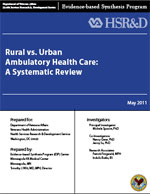
|
Investigators: Michele Spoont, PhD; Nancy Greer, PhD; and Jenny Su, PhD Evidence-based Synthesis Program (ESP) Center, Minneapolis VA Medical Center Washington (DC): Department of Veterans Affairs; May 2011. |
Download PDF: Complete Report, Executive Summary, Report, Appendices
Approximately 3 million veterans, slightly more than one-third of all veterans enrolled in the Department of Veterans Affairs (VA) health care system, live in rural areas. This pattern is likely to continue, as a comparable proportion of Operation Enduring Freedom/Operation Iraqi Freedom (OEF/OIF) veterans are from rural areas. The Rural Veterans Care Act of 2006 was signed into law to improve care for rural veterans. Ensuring that the health care needs of rural veterans are met has become a top priority for VA, resulting in a considerable expansion of community based outpatient clinics (CBOCs), inclusion of rural health/access as a research priority, and creation of the VA Office of Rural Health (ORH) in 2006.
Although there have been reports comparing health quality of life (both physical and mental) for rural and urban veterans, it remains unclear whether the observed lower health quality of life in rural veterans is due to disparities in health care, differences in disease prevalence, or other population differences. This systematic review examines the evidence regarding potential disparities between rural and urban areas in health care provision and delivery, and how differences in health care may contribute to disparities in health outcomes. Differences in rural-urban prevalence rates of diseases and other health conditions are beyond the scope of this review. Because veterans who use VA health care have been found to use more non-VA health care overall, we expanded the focus of this review to include comparisons of rural vs. urban health care in non-VA health systems.
The systematic literature review addressed the following key questions: